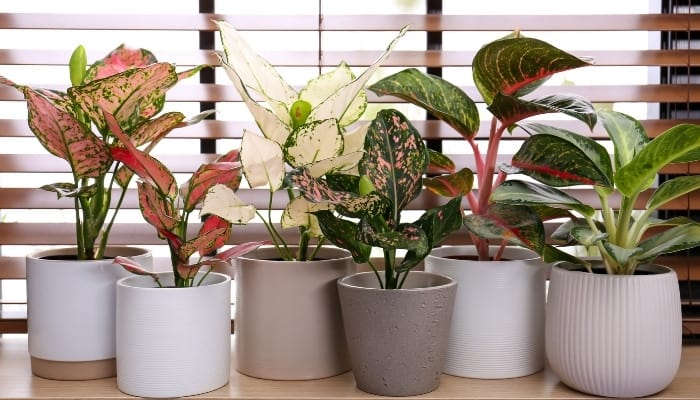Losing interest in a new houseplant is common when the nursery or garden center fails to provide adequate information on how to properly care for it.
While you know all plants need water and occasional fertilizer, finding the right lighting for your plant can be tricky.
Incorrect light may not immediately affect the health of your plant, but the plant will slowly decline when proper conditions are not met.
In addition, the continuous stress from trying to survive in incorrect lighting will make the plant less equipped to fight against disease or pests.
Is direct or indirect light better for plants? The amount of light needed for a plant to thrive varies based on the type of plant. Many outdoor plants require direct sunlight, while others need partial sun or full shade. For most houseplants, bright, indirect light is optimal. Always check your specific plant’s lighting requirements.
If your plant is not thriving, is starting to get leggy, or is putting out small leaves, these may be signs that it is not receiving the correct amount of light.
It is important to correct the lighting situation for the plant before its overall health rapidly declines. Read on to learn the ins and outs of houseplant lighting requirements.
Direct vs. Indirect Sunlight
It is very easy to determine direct and indirect sunlight outdoors. You simply look where your lawn is sunny versus where your lawn is shaded.
Most light indoors is considered indirect light, because the sun’s rays are not directly shining on the plant. However, there are different levels of indirect light, ranging from low to bright light.
What Is Direct Light for Plants?
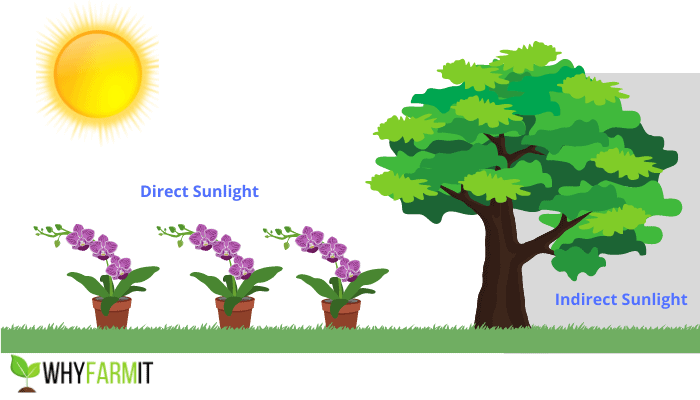
Direct light is when the sun’s rays hit the plant without any obstruction. Inside, this will usually only occur when the plant is placed on a windowsill or close to a glass door.
Any plants that require “full sun” or many hours of direct sunlight cannot be grown indoors.
When the direct sun is hitting a plant, there will be a single, dark shadow being cast in the opposite direction that the light is coming from.
Is Direct Light Bad for Plants?
In the houseplant world, direct sunlight can get a bad name, but it is not always the villain. Most houseplants do not need any direct light and will grow better without it.
However, some plants can tolerate small amounts of direct light, especially morning sun which is not as harsh.
Succulents, snake plants, and crotons are examples of houseplant varieties that will not only tolerate direct light but will also thrive in it.
If you have a location in your home that direct light cannot be avoided, these are some of the plants that you can place there.
Is Morning Sun Direct Sunlight?
Morning sun is considered to be direct sunlight. However, it is typically less severe than the afternoon sun.
Many houseplants will be okay with a couple of hours of the direct morning sun.
This is also a great lighting option for indoor plants that need more sunlight to bloom but cannot handle strong direct sun rays.
What Is Indirect Light for Plants?
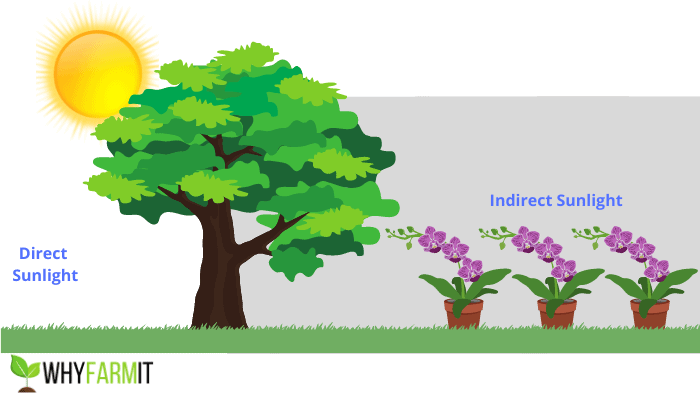
Indirect light is like ambient lighting. Rays are not directly touching the plant, but the plant is not in the darkness.
Indirect light is found in most rooms that have a window. Windows with the direct sun can be dressed with a thin curtain to create indirect lighting.
Plants that are marked as low light and partial/full shade typically do well in indirect light conditions.
What Does Indirect Light Look Like?
The sun’s rays will not directly hit the leaves of your plant. Instead, the light bounces off of other objects creating general lighting in the room.
Instead of one dark shadow, you may see multiple faint shadows being cast in different directions.
What Counts as Bright Indirect Light?
Brightness is not a quantifiable measurement, so it can be hard for plant owners to determine how much light is needed to create “bright, indirect light.”
First, the light should be indirect, meaning that the sun’s rays of light should not be directly hitting the plant at all. Bright means a higher intensity or level of ambient light.
Typically, the brightest indirect light will be located close to a window or glass door. You will often see darker shadows in bright light compared to low light.
How To Measure Light Levels for Plants
If you’re still unsure of the lighting levels throughout your home, there are a couple of methods you can use to better define the amount of light.
Some methods are more scientific than others, but they should all give you a better understanding of the lighting in your home.
Shadow Test
During the brightest time of day (usually around noon), hold up your plant or your hand and observe the resulting shadow:
Direct light: dark shadow with a well-defined outline.
Bright light: one or a couple of moderately dark shadow(s) with slightly blurred edges.
Low light: Multiple faint shadows with indistinct outlines.
Depending on how much light your plant needs, you can recreate the shadow test throughout the day (since the sun’s movement will cause different light levels).
If a majority of the tests fit a certain light category, you can determine which plants would do best in that location.
If you get different categories throughout the day, keep that in mind when choosing which plant to house in that location.
Light Meter
If you’d like to nerd out on the estimated amount of light a location is receiving, purchase a light meter or download an app on your smartphone.
A light meter measures the number of foot-candles (an outdated measure of illumination – one unit equals the illumination of one candle at a 1-foot distance).
Your light meter may also measure in lux, which is approximately 1/10th of a foot-candle.
When using a light meter app on your smartphone, set the app to outdoor measurement (even when you are using it indoors) and face the camera in the direction of the light source (window).
For an actual light meter, you will uncover the sensor and face it in the direction of the light source. Based on the reading, you can determine the light level for that location:
- 25-100 foot-candles (ftc): low, indirect light
- 100-500 ftc: medium, indirect light
- 500-1000 ftc: high, indirect light
- 1000+ ftc: direct sunlight
For the most accurate readings, I’d recommend this rapid-response model with a backlit screen and rotating sensor so you only need to aim in the direction you wish to measure.
Plant Growth/Appearance
This measure of light is a matter of trial and error. If a plant is recommended for bright, indirect light, place it where you believe the environment provides bright, indirect light.
It can take weeks or months (depending on the growth rate of the plant) to see any detrimental effects from incorrect lighting.
Some signs that the plant needs more light include:
- Growing heavily towards the light source.
- Leggy or sparse growth.
- No new growth.
- Small leaves.
- Soil not drying out.
- Losing variegation.
- Dark green leaves.
Some signs that the plant needs less light include:
- Dry, crispy leaves.
- Sunburn spots.
- Brown edges.
- Light-colored foliage.
Many of these signs could also be caused by pests, disease, or a water imbalance. Make sure all other aspects of plant care are taken care of correctly when experimenting with light levels.
Which Direction Gets the Most Light?
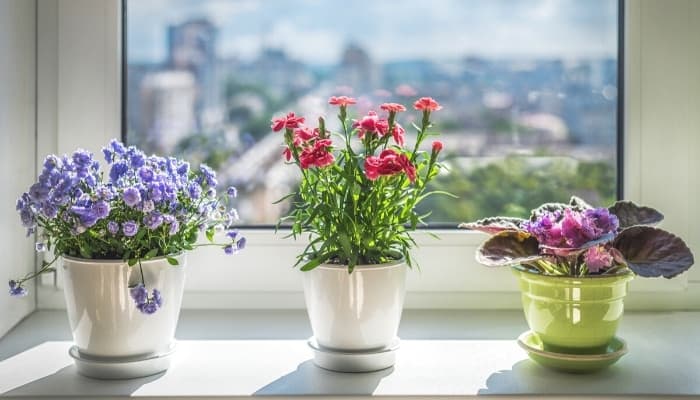
For those in the Northern Hemisphere, a south-facing window will receive the most light. This is because the sun stays close to the equator throughout the year.
The sun also moves from east to west throughout the day, meaning those directions will get primarily morning or afternoon sun.
Indirect Light vs. Shade
Shade and indirect light are the same thing, except the terms are typically used in different ways.
Outdoors, shade describes an area where the sun’s rays do not shine directly. This is usually next to a building or trees that block the sun.
Indoors, indirect light describes lighting where the sun’s rays do not directly hit the plant.
Technically, all indoor space (except where direct sun rays come through a window) is considered shade because of the roof overhead and the surrounding walls.
Since some plants can be grown indoors or outdoors, look for outdoor plants marked for “shade” if you’d like to try growing them as houseplants.
What Is Partial Sunlight?
Partial sunlight is defined as 3-6 hours of direct sunlight per day. This is easier to achieve in outdoor locations.
However, it can also be achieved in west-, south-, or east-facing windows indoors.
Some plants will be okay in bright, indirect light instead of partial sunlight.
This may not be the optimal lighting condition for them, though. Therefore, the plant may not bloom or grow to its full potential.
Is Light Through a Window Considered Direct Sunlight?
Technically, sunlight shining through a window is partially refracted and obscured, meaning it is not 100% direct sunlight.
Only in outdoor conditions can true direct (sun to plant, without interference) sunlight be achieved.
However, in terms of houseplants, the rays of sunlight coming through a window are described as direct sunlight.
This is because this is the most direct/most intense form of light available in an indoor setting.
Since most houseplants are better suited for filtered or indirect lighting conditions, direct sunlight outside or through a window can be too intense for the plants.
If a window does receive direct sunlight, a thin curtain can filter the intensity of the light causing it to become indirect.
North-Facing Windows
For the Northern Hemisphere, north-facing windows rarely receive direct sunlight. This means they typically create an environment of bright, indirect light throughout the entire day.
South-Facing Windows
Sun-loving plants will do best in south-facing windows because these windows typically receive the most direct sun throughout the day (in the Northern Hemisphere).
East-Facing Windows
East-facing windows will receive direct sun in the morning when the light is not as intense and typically less damaging to sensitive plants.
This is a good location for houseplants that require ample sunlight to bloom but cannot handle too much harsh, direct light.
West-Facing Windows
West-facing windows will receive direct afternoon sun during the hottest part of the day. These conditions can be too extreme for many houseplants.
In addition, the morning light can be too low for most plants.
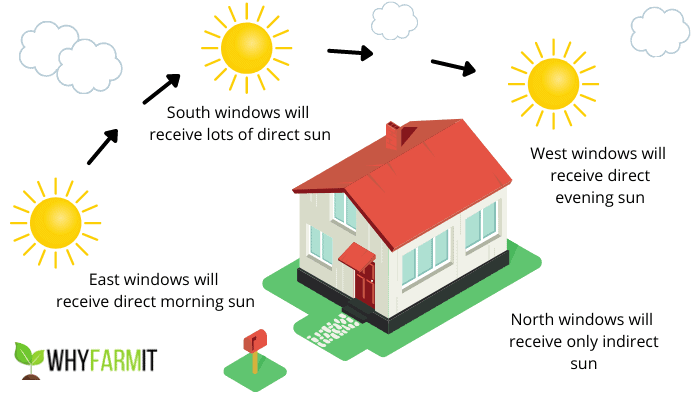
What Type of Plants Need Direct Sunlight?
Some varieties of houseplants that need at least four hours of direct sunlight include:
- Jade Plant
- Succulents
- Crotons
- Kalanchoes
- Aloes
- Herbs
What Type of Plants Need Indirect Sunlight?
Most other houseplants need varying levels of indirect sunlight. However, remember that indirect sunlight can have varying levels of intensity.
Bright, Indirect Light
- Peperomia
- Wax Plant
- Begonia
- Philodendron
- Fiddle Leaf Fig
- Monstera
- Calathea
- Staghorn Fern
Low Light
- Bamboo Palm
- Cast-iron Plant
- Snake Plant
- ZZ Plant
How To Tell If Your Plants Are Getting Too Much Light
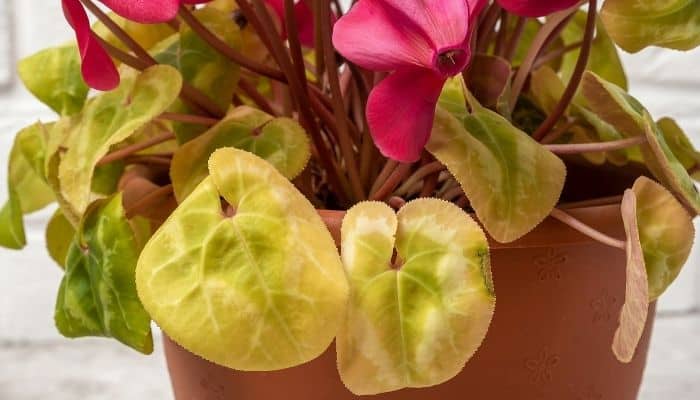
There are a few signs that indicate your plant is getting too much light. A great indicator is how quickly the plant and soil dry out.
For a plant that requires a moderate amount of water, it should take approximately one week for the top couple inches of soil to dry out.
If the soil is drying out quicker and the plant seems parched, it is probably receiving too much sun.
Some other indicators that the plant is getting too much light include:
- Dry, crispy leaves.
- Sunburn spots.
- Pale coloration.
- Brown edges.
Are Grow Lights Direct or Indirect Light?
The grow lights used by most hobby plant growers are considered indirect light.
For professional nursery operations and serious enthusiasts, there are grow lights strong enough to mimic direct sunlight.
Is Indirect Light the Same as Filtered Light?
Filtered light is achieved when something interferes with the direct sun rays. For houseplants, this is usually a sheer curtain. By filtering the direct light, indirect light is achieved.
Is Indirect Sunlight Enough for Indoor Plants?
Each plant will have different lighting requirements, but for most houseplants, indirect sunlight is plenty of light.
Be mindful of leaving your plant in low, indirect light, however. Even indoor plants still need enough light to complete photosynthesis.
Is Morning Sun Better Than Afternoon Sun for Plants?
Many houseplants are suited for indirect light and are too sensitive to harsh direct sunlight.
Since the morning sun is less severe, some houseplants can handle (and even enjoy) the more subtle direct light.
Conclusion
Now that direct and indirect light has been thoroughly explained, you can set your plants up to thrive inside.
By choosing the best location for a plant’s lighting needs, you are fulfilling the number one necessity for growing a beautiful, healthy plant.

